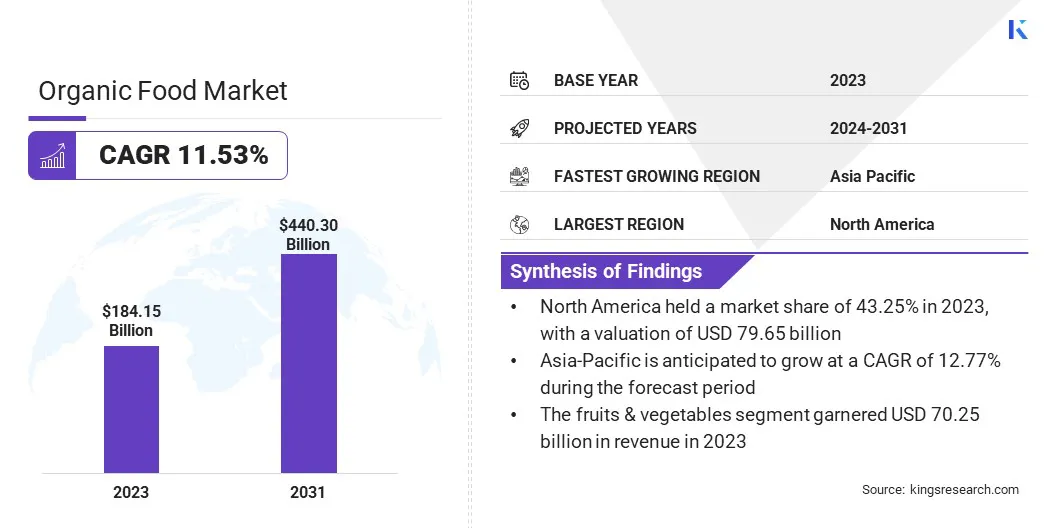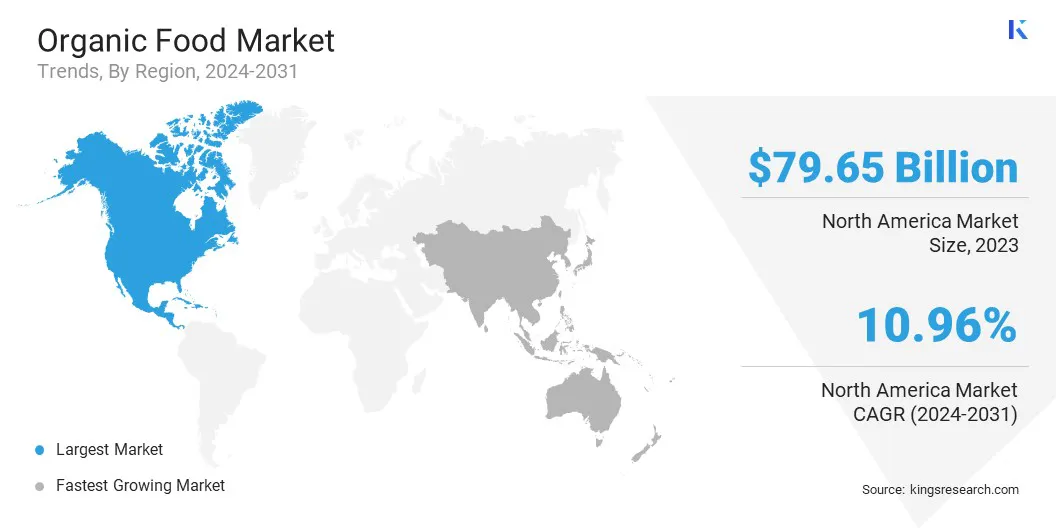Organic Food Market Size
The global Organic Food Market size was valued at USD 184.15 billion in 2023 and is projected to reach USD 440.30 billion by 2031, growing at a CAGR of 11.53% from 2024 to 2031. The market is experiencing steady growth driven by increasing health consciousness, environmental sustainability concerns, and stringent regulations.
In the scope of work, the report includes products offered by companies such as Danone SA, General Mills, Inc., Hain Celestial Group, Inc., Organic Valley, Nestlé SA, The Kraft Heinz Company, United Natural Foods, Inc. (UNFI), WhiteWave Foods Company, SunOpta Inc., Dean Foods Company and others.
Challenges such as high production costs and limited infrastructure are being addressed through innovation and partnerships. Potential growth opportunities lie in emerging markets, product diversification, and technological advancements for sustainable practices.
The increasing health awareness among consumers significantly drives the growth of the organic food market. Health-conscious individuals seek healthier dietary options due to concerns regarding obesity, diabetes, and cardiovascular diseases, leading to a rising preference for organic food, which is perceived as safer and more nutritious.
Additionally, the rising awareness of health risks associated with conventional farming practices, such as pesticide residues on food, has led to a shift in consumer preferences towards organic alternatives. This increased demand is prompting food producers to expand their organic product lines, retailers to allocate more shelf space for organic offerings, and farmers to adopt organic farming practices to meet consumer demands.
Organic food refers to agricultural products grown and processed without synthetic pesticides, fertilizers, genetically modified organisms (GMOs), antibiotics, or hormones. It emphasizes sustainable farming practices, biodiversity, and ecological balance. Organic food has applications in various sectors, including fresh produce, dairy products, grains, meat, and processed foods.
Consumers choose organic food for its perceived health benefits, environmental sustainability, and support for ethical farming practices, thereby driving its demand across global markets.

Analyst’s Review
Businesses must adopt key strategies to thrive in the organic food industry. Focusing on innovation and product differentiation may set companies apart in a crowded market, attracting discerning consumers who seek novel experiences. Building strong partnerships and collaborations with organic farmers, suppliers, and retailers is enhancing supply chain efficiency and market reach.
Leveraging digital marketing channels and e-commerce platforms to connect directly with consumers and offer transparent information about product origins and certifications is essential. Additionally, investing in sustainability initiatives and eco-friendly packaging may appeal to environmentally conscious consumers and align with corporate social responsibility goals.
Moreover, compliance with organic certification standards plays a key role in establishing consumer trust and demonstrating a commitment to quality and transparency.
Regulatory frameworks provide guidelines for organic farming practices, labeling requirements, and product quality assurance, safeguarding consumer interests and promoting market integrity. Companies that prioritize adherence to regulatory standards gain credibility and competitive advantage in the organic food market.
Organic Food Market Growth Factors
Changing consumer preferences towards natural and organic ingredients is significantly driving the growth of the organic food market. Health-conscious and environmentally aware consumers seek food products that align with their values and lifestyle choices, driven by rising concerns over health issues related to conventional food production.
Organic food is perceived as healthier, safer, and more environmentally sustainable due to its production methods that avoid synthetic chemicals and promote sustainable farming practices.
The increase in millennials and Generation Z consumers with a focus on wellness and ethical consumption further contributes to the demand for organic food products across various categories. Companies that offer a diverse range of high-quality organic products can capitalize on this trend and gain a competitive edge in the organic food industry.
Additionally, the market is experiencing steady growth as a result of the rising emphasis on product innovations. Ongoing research and development efforts are focused on improving organic food processing, packaging, and preservation techniques to address key challenges such as maintaining product quality, extending shelf life, and aligning with eco-conscious consumer preferences.
Advanced processing methods and sustainable packaging solutions enhance the nutritional value, taste, and environmental impact of organic products, thereby catering to evolving consumer demands. These innovations attract new consumer segments, foster repeat purchases, and build brand loyalty, contributing significantly to the growth and sustainability of the global organic food market.
However, the limited supply chain infrastructure poses a significant challenge to the growth of the organic food market. In regions with inadequate infrastructure for organic farming, processing, storage, and distribution, businesses face obstacles in meeting the growing demand for organic products.
This lack of infrastructure can lead to increased costs and supply chain disruptions, which, in turn, is affecting the availability and affordability of organic foods for consumers.
Additionally, limited infrastructure hinders the scalability of organic farming practices, thereby impacting overall customer satisfaction and brand reputation. Addressing this challenge requires investments in developing robust organic supply chains, improving storage and logistics facilities, and implementing sustainable distribution networks.
Moreover, collaborations between government agencies, private sector stakeholders, and NGOs may play a crucial role in overcoming infrastructure limitations and promoting the demand for organic foods.
Organic Food Market Trends
The trend of personalized nutrition fosters market expansion by catering to the diverse and evolving dietary preferences of consumers. Customized organic food products and meal plans address specific health goals, allergies, genetic factors, and lifestyle choices, thereby enhancing consumer satisfaction and loyalty.
Advanced analytics and biotechnology enable companies to gather and analyze data to create personalized recommendations and products, which is driving product development, marketing strategies, and consumer engagement, thereby expanding market reach and revenue opportunities.
Moreover, implementing regenerative farming practices in the organic food industry aligns with sustainability efforts, along with focusing on ecosystem restoration and soil health improvement. Consumers are increasingly conscious of environmental issues and seek products aligned with ethical and sustainable practices.
Companies adopting regenerative agriculture reduce environmental impact while differentiating themselves in the market. This trend fosters market expansion by aligning with consumer values, enhancing brand reputation, and driving demand for organic products produced through regenerative practices.
Collaborations with farmers, NGOs, and government bodies to promote and incentivize regenerative agriculture further accelerate market growth and sustainability efforts.
Segmentation Analysis
The global organic food market is segmented based on product type, sales channel, and geography.
By Product Type
Based on product type, the market is segmented into fruits & vegetables, dairy, herbs/spices & condiments, meat, fish & poultry, processed food products, and others. The fruits & vegetables segment garnered the highest valuation of USD 70.25 billion in 2023 due to growing consumer awareness of the health benefits associated with consuming fresh organic produce.
- A recent review by the USDA's Economic Research Service (ERS) examining 223 studies found significant differences in nutrient levels, with fruits and vegetables often containing higher levels of certain antioxidants, iron, and magnesium compared to processed foods. This scientific evidence reinforces consumers' perceptions of fruits and vegetables as essential components of a healthy diet, driving increased consumption and market value within this segment.
By Sales Channel
Based on sales channel, the market is bifurcated into hypermarket/supermarket, specialty store, online retails, and other retail format. The hypermarket/supermarket segment secured the largest revenue share of 44.32% in 2023 due to the significant growth in organic food sales in these retail settings.
- According to the Organic Trade Association (OTA), organic food sales in the US exceeded USD 63 billion between 2020 and 2022, outpacing the sales increase of conventional groceries typically found in hypermarkets and supermarkets.
The increasing preference of consumers for organic products, coupled with the convenience and variety offered by hypermarkets/supermarkets, has driven substantial organic food sales through these channels, contributing to the dominance of the segment in the market.
Organic Food Market Regional Analysis
Based on region, the global organic food market is classified into North America, Europe, Asia-Pacific, MEA, and Latin America.

The North America Organic Food Market share stood around 43.25% in 2023 in the global market, with a valuation of USD 79.65 billion. The National Organic Program (NOP) by the Agricultural Marketing Service (AMS) showcased a steady increase in certified organic acres in the US, indicating ongoing growth in organic production and consumption.
This growth is driven by factors such as consumer awareness of health and environmental benefits, stringent organic certification standards, and the availability of organic products across various retail channels. These trends contribute to the region’s prominence in the global organic food market.
Asia-Pacific is poised to experience significant growth at a CAGR of 12.77% over the forecast period, with China registering notable organic retail sales growth.
The recent report by the Organization for Economic Co-operation and Development (OECD) on organic agriculture highlights China's notable growth rate in organic retail sales. This trend underscores the increasing consumer demand for organic products in China, reflecting evolving preferences toward healthier and sustainable food choices in one of the world's largest consumer markets.
Competitive Landscape
The global organic food market report will provide valuable insight with an emphasis on the fragmented nature of the industry. Prominent players are focusing on several key business strategies such as partnerships, mergers and acquisitions, product innovations, and joint ventures to expand their product portfolio and increase their market shares across different regions.
Strategic initiatives, including investments in R&D activities, the establishment of new manufacturing facilities, and supply chain optimization, could create new opportunities for market growth.
List of Key Companies in Organic Food Market
- Danone SA
- General Mills, Inc.
- Hain Celestial Group, Inc.
- Organic Valley
- Nestlé SA
- The Kraft Heinz Company
- United Natural Foods, Inc. (UNFI)
- WhiteWave Foods Company
- SunOpta Inc.
- Dean Foods Company
Key Industry Developments
- October 2023 (Partnership): Tyson Foods announced a partnership with Protix to explore more sustainable protein sources, indicating a growing interest among major food companies in sustainable and organic food production. This collaboration underscored the industry's shift towards environmentally friendly practices and meeting the rising demand for organic and sustainable food options.
- April 2023 (Investment): General Mills announced the advancements in regenerative agriculture, marked by a strategic investment in sustainable food production. This investment reflected the company's recognition of the burgeoning demand for eco-friendly and ethically sourced organic food products. By prioritizing soil health initiatives and sustainable farming practices, General Mills aimed to capitalize on the expanding growth opportunities in the organic food sector.
The global Organic Food Market is segmented as:
By Product Type
- Surface Imaging
- Inside Imaging
- See-through Imaging
- Microscopy
- Biosensors
- Medical Lasers
- Spectromolecular Technologies
By Sales Channel
By Region
- North America
- Europe
- France
- U.K.
- Spain
- Germany
- Italy
- Russia
- Rest of Europe
- Asia-Pacific
- China
- Japan
- India
- South Korea
- Rest of Asia-Pacific
- Middle East & Africa
- GCC
- North Africa
- South Africa
- Rest of Middle East & Africa
- Latin America
- Brazil
- Argentina
- Rest of Latin America


